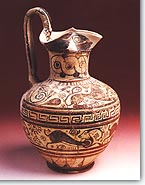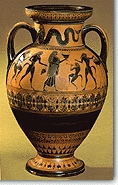









         | |
|
The transition from the sub-Geometric ceramics to that of the Archaic period is more apparent in the type of "bird or rosette kylikes", as they are called, based on their decoration. Presumably that they appeared for the first time in Rhodes at the beginning of the |
 |
Another type of written ceramics from eastern Greece is the known "Wild Goat style", which was produced in many workshops between |
 | Among other workshops we can note those of Rhodes, from which come the "group of Vroulia" with red and white floral motifs over a grey black coating. Some groups of vases with rich representations and careful design, which have been found exclusively in Etruria, were occasionally associated with workshops of eastern Greece. These are the Caeretan hydries, as well as the groups of Northampton and Campana. The latter two groups are associated with Clazomenae, whereas those of hydries to Phocaea. However, the most probable theory is that all these vases were created by ceramists emigrating to Italy, most probably during the time of the wave of migration created by the Persian conquest of Ionia. |
|
| |
|
Note: Click on picture for short description. | |